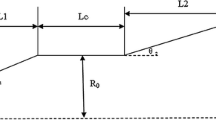Abstract
Megawatt-class gyrotron oscillators for electron cyclotron heating and non-inductive current drive (ECH&CD) in magnetically confined thermonuclear fusion plasmas have relatively low cavity quality factors in the range of 1000 to 2000. The effective length of their cavities cannot be simply deduced from the cavity electric field profile, since this has by far not a Gaussian shape. The present paper presents a novel method to estimate the effective length of a gyrotron cavity just from the eigenvalue of the operating TEm,n mode, the cavity radius and the exact oscillation frequency which may be numerically computed or precisely measured. This effective cavity length then can be taken to calculate the Fresnel parameter in order to confirm that the cavity is not too short so that the transverse structure of any mode in the cavity is the same as that of the corresponding mode in a long circular waveguide with the same diameter.





Similar content being viewed by others
References
A. G. Fox, T. Li, “Resonant modes in a maser interferometer”, Bell System Technical Journal, vol. 40, pp. 453-488, 1961.
L.A. Weinstein, “Open resonators and open waveguides”, The Golem Press, Golem Series in Electromagnetics, Boulder, p. 34, pp. 134-144, 1969.
G. Nusinovich, “Introduction to the physics of gyrotrons”, The Johns Hopkins University Press, Baltimore and London, pp. 32-34, 2004.
M. Glyavin, N. Ginzburg, A. Luchinin, V. Manuilov, M. Morozkin, G. Nusinovich, O. Plankin, A. Sedov, V. Zapevalov, V. Zaslavsky, N. Zavolsky, I. Zotova, T. Idehara, T. Saito, “Numerical analysis of THz gyrotrons operation conditions for efficient generation of cyclotron harmonics”, FIR Center Report, FIR FU-121, Research Center for Development of Far-Infrared Region, University of Fukui, Fukui, Japan, 2013.
G.S. Nusinovich, M.K.A. Thumm, M.I. Petelin, “The gyrotron at 50: Historical overview”, Journal of Infrared, Millimeter and Terahertz Waves, vol. 35, pp. 325-381, 2014.
A. Roy Choudhury, “Investigations of after cavity interaction in gyrotrons including the effect of non-uniform magnetic field”, KIT Scientific Publishing, Karlsruher Forschungsberichte aus dem Institut für Hochleistungsimpuls- und Mikrowellentechnik, vol. 4, Karlsruhe, ISBN 978-3-7315-0129-9, 2014.
G. Dammertz, S. Alberti, A. Arnold, E. Borie, V. Erckmann, G. Gantenbein, E. Giguet, R. Heidinger, J.-P. Hogge, S. Illy, W. Kasparek, K. Koppenburg, M. Kuntze, H.P. Laqua, G. LeCloarec, Y. LeGoff, W. Leonhardt, C. Lievin, R. Magne, G. Michel, G. Müller, G. Neffe, B. Piosczyk, M. Schmid, M. Thumm, M.Q. Tran, “Development of a 140 GHz, 1 MW, continuous wave gyrotron for the W7-X stellarator”, IEEE Transactions on Plasma Science, vol. 30, no. 3, pp. 808-818, 2002.
S. Kern, “Numerical codes for interaction calculations in gyrotron cavities at FZK”, Proc. 21 st International Conference on Infrared and Millimeter Waves, July 14-19, 1996, Berlin, Germany, AF2.
A. Schlaich, G. Gantenbein, J. Jelonnek, M. Thumm, “Transient millimeter-wave signal analysis with unambiguous RF spectrum reconstruction“, IEEE Transactions on Microwave Theory and Techniques, vol. 61, no. 12, pp. 4660-4666, 2013.
J. Jelonnek, F. Albajar, S. Alberti, K. Avramidis, P. Benin, T. Bonicelli, F. Cismondi, V. Erckmann, G. Gantenbein, K. Hesch, J.-P. Hogge, S. Illy, Z.C. Ioannidis, J. Jin, H. Laqua, G.P. Latsas, F. Legrand, G. Michel, I.G. Pagonakis, B. Piosczyk, Y. Rozier, T. Rzesnicki, I.G. Tigelis, M. Thumm, M.Q. Tran, J.L. Vomvoridis, “From series production of gyrotrons for W7-X toward EU-1MW gyrotrons for ITER” , IEEE Trans. on Plasma Science, vol. 42, no. 5, 1135-1144 (2014).
M. Thumm, J. Franck, S. Illy, K.A. Avramidis, P.C. Kalaria, J. Jelonnek, “Towards a high-power millimeter wave gyrotron for DEMO”. Proc. 5th Int. Workshop on Far-Infrared Technologies (FIRT 2014), March 5-7, 2014, Fukui, Japan, 5p-8.
Acknowledgments
The author would like to thank his colleagues of the Institute Pulsed Power and Microwave Technology (IHM) at Karlsruhe Institute of Technology (KIT), Karlsruhe, Germany, Mikhael Glyavin of the Institute of Applied Physics, RAS, Nizhny Novgorod, Russia, and Gregory Nusinovich of the Institute for Research in Electronics and Applied Physics, University of Maryland, USA for providing useful information and for very fruitful discussions.
Author information
Authors and Affiliations
Corresponding author
Rights and permissions
About this article
Cite this article
Thumm, M. Effective Cavity Length of Gyrotrons. J Infrared Milli Terahz Waves 35, 1011–1017 (2014). https://doi.org/10.1007/s10762-014-0102-z
Received:
Accepted:
Published:
Issue Date:
DOI: https://doi.org/10.1007/s10762-014-0102-z



